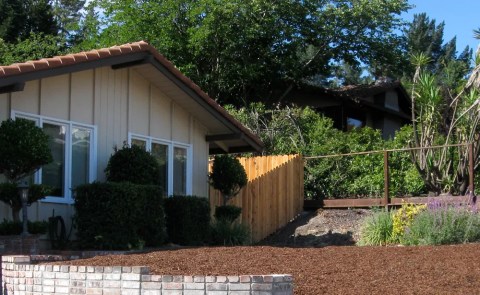Lawn to Garden Conversion with a Weed Cloth Phase
This is how we usually do lawn conversions these days, a modified version of sheet mulching. Unlike the last lawn I showed, which was mostly just regular turf grass, this lawn had bermuda grass in it, a tougher beast to slay, really tenacious at fighting its way up through newspaper or cardboard. Instead of immediately sheet mulching and planting, I find it better to first cover the lawn with weed cloth and mulch for a few months — letting the Bermuda grass expend energy trying to fight up through the cloth — and then attack it wherever it makes it to the surface. It takes a little more patience, but it doesn’t add much labor or cost. It’s easy enough, once I’m ready to plant, to sweep the mulch off, pull the cloth, and finish off the Bermuda grass while I do the grading and prep for the new planting. Then, I do the new planting and put the mulch back on top of it, take the weed cloth off to use on my next project. Lawns are easy to kill, it’s the weeds in the lawn that sometimes take a little extra care.
Above is a before view from google earth, below is the lawn covered by mulch during the summer. The Bermuda grass came back especially strong at the edges, where it had roots going underneath the concrete of the front walkway and the curb. We got it pretty well by the time we finished the installation, but it still requires vigilance along the walkway.
A lot of lawn conversions involve adding a path through the new planting. This one needed steps as well.
Before and after views from a couple more angles are below. As I said in my last post, a front garden’s a lot better than a tired old lawn.
This is the first year of the planting. I used a lot of Manzanitas, which start small and take a few years to develop a presence, so Daffodils added some interest this spring. Above is the planting after six months, below is after about eight, with the Nepeta, Salvia, and Yarrow in bloom.
Above is a google earth view. The Magnolia was gone before I saw it, taken out because it’s roots had broken apart the brick circle in several places and had invaded the lawn. We got rid of the circle while we were doing the repair, reorienting the wall so it follows the curve of the front walk as a simple retaining wall.
This entry was posted on Saturday, June 10th, 2017 at 1:09 pm and is filed under lawn to garden, private gardens. You can follow any responses to this entry through the RSS 2.0 feed. You can leave a response, or trackback from your own site.













